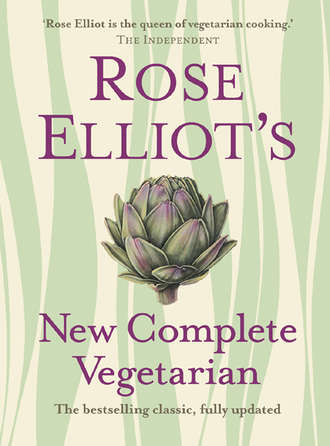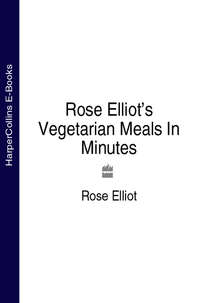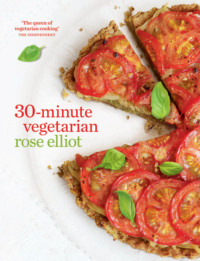
Полная версия
Rose Elliot’s New Complete Vegetarian
Check the seasoning before serving the mushrooms on individual plates with a scattering of chopped parsley on top.
Pears with blue cheese and walnuts
The secret to this dish is using really ripe, sweet pears. I find it’s safest to buy hard pears up to a week in advance and let them ripen gently at room temperature. Small pears with a rounded shape work best – Comice are perfect.
SERVES 4
4 ripe sweet pears
juice of 1 lemon
1 tbsp extra-virgin olive oil
salt and freshly ground black pepper
50g (2oz) shelled walnuts pieces
125g (4oz) watercress
125–175g (4–6oz) Stilton or Danish Blue cheese, broken into pieces
Preheat the grill if you are toasting the walnuts. Peel the pears and cut into even-sized pieces, removing the core. Put into a bowl with the lemon juice, oil, some salt and a generous grinding of pepper, and mix together.
Spread the walnuts on a grill pan and toast under the hot grill for a few minutes until they smell wonderful, but be careful not to burn them. Or use them untoasted if you prefer.
Arrange the watercress on four plates. Spoon the pears on top and divide the dressing between the plates.
Tuck pieces of cheese among the pears and watercress, and scatter with the walnuts, breaking them up a bit in your fingers as you do so. If they’re still warm from the grill when you serve them, that’s even better.
Salsify with butter, parsley and lemon
Salsify – and their close relative, scorzonera – look like long, rather dirty dark roots when you see them in the shops, but when they’re peeled and cooked they have a delicious, delicate flavour.
SERVES 4
1kg (2 lb) salsify or scorzonera (unpeeled weight)
2 tbsp lemon juice
salt
25g (1oz) butter
freshly ground black pepper
2 tbsp chopped fresh flat-leaf parsley
Peel the roots, keeping them under cold water to preserve the colour. Cut them into 2.5cm (1in) pieces and put them straight into a bowl of cold water with 1 tablespoon of lemon juice.
Bring 2.5cm (1in) of salted water to the boil in a large saucepan, add the roots and cook for about 10 minutes or until just tender.
Drain and add the butter, the remaining lemon juice, the parsley and salt and pepper to taste. Heat gently to melt the butter, then serve at once.
Salsify fritters
These delicate fritters make a perfect first course.
SERVES 4
700g (1 lb) salsify or scorzonera
3 tbsp red wine vinegar
1–2 tbsp chopped fresh herbs (e.g. parsley or dill)
salt and freshly ground pepper
125g (4oz) plain flour
1 tbsp olive oil
2 eggs, separated
150ml (5fl oz) water
vegetable oil, for deep-frying
lemon slices, to serve
Prepare and cook the salsify as described in the first two paragraphs of the previous recipe. Drain well, then sprinkle with the vinegar, herbs and some salt and pepper.
Mix together the flour, oil, seasoning, egg yolks and water to form a batter. Whisk the egg whites, then fold into the batter.
Heat enough oil to half fill a medium-sized saucepan to 190°C (375°F) (or when a little batter sizzles if dropped into the oil). Coat the salsify pieces in batter, then fry for about 4 minutes or until browned. Drain and serve with the lemon slices.
Salsify mayonnaise
Cooked and mixed with mayonnaise, salsify makes a lovely dish that I think of as the vegetarian equivalent to a light fish dish, though I can’t swear to this as I haven’t eaten fish since I was three years old!
SERVES 4
1kg (2 lb) salsify or scorzonera
2 tbsp lemon juice
3 tbsp mayonnaise
3 tbsp natural yoghurt
TO GARNISH
1 tbsp chopped fresh flat-leaf parsley
lemon slices
Peel and cook the salsify until tender. While still hot, add the lemon juice, mayonnaise and yoghurt. Leave to cool.
Serve on individual plates, garnished with the parsley and lemon slices.
Easy spring rolls v
These may seem fiddly, but actually they’re easy to make and delicious served with a sweet chilli dipping sauce.
MAKES 24 SPRING ROLLS
1 onion, chopped
1 tbsp olive oil
335g packet beansprouts
1 small pointed red pepper, deseeded and sliced
1 garlic clove, crushed
a thumb-sized piece of fresh root ginger, peeled and grated or finely chopped
head of Chinese leaves, shredded
3 tbsp dark soy sauce
salt
270g packet filo pastry (6 sheets, approximately 500mm × 240mm (20in × 9 in))
rapeseed or groundnut oil, for brushing
sweet chilli sauce, to serve
Fry the onion in the oil in a large saucepan for 5 minutes or until beginning to soften. Add the bean sprouts, red pepper, garlic, ginger and Chinese leaves, stir-fry for a further 5 minutes or until the vegetables are tender. Add the soy sauce and some salt to taste, then leave to cool.
Preheat the oven to 200°C (400°F), gas mark 6.
Cut each sheet of filo pastry in half right down the middle, and across, making 24 rectangles.
Take one rectangle of filo pastry. Put about a tablespoon of the vegetable mixture across the filo, about 1cm (½in) from the top. Fold over the top, and fold over the sides, then roll the pastry to make a spring roll shape.
Brush the spring roll with oil, or put some oil on a plate and dip the spring roll in this, to coat lightly. Place the spring roll on a baking sheet and repeat with the rest of the mixture until all the filo and (probably) all of the vegetable mixture is used.
Bake the spring rolls for about 10 minutes or until crisp and golden brown. Serve with a chilli dipping sauce.
Sweet potato bhajis v
These crisp tasty morsels make a tempting starter or nibble. They’re great with mango chutney, tomato salsa or cucumber and coriander raita; or add some hot cooked rice to make a light main course.
MAKES 8 / SERVES 4 AS A STARTER, 2 AS A MAIN COURSE
350g (12oz) sweet potato
1 onion, very finely chopped
125g (4oz) chickpea flour
1 tsp dried red chilli flakes
1 tsp baking powder
1 tsp salt
3 tbsp chopped fresh coriander
vegetable oil, for deep-frying
Peel and grate the sweet potatoes, then put into a bowl and add the onion, chickpea flour, chilli flakes, baking powder, salt and coriander. Mix well; as you mix, the moisture from the vegetables will be drawn out and will bind everything together. Add a tablespoonful or so of water only if the chickpea flour remains dry.
Heat enough oil in a medium-sized saucepan for deep-frying. (The pan needs to be half full of oil.) When the oil reaches 180°C (350°F), or a cube of bread rises to the surface and turns golden brown in under 1 minute, put in 3–4 dessertspoons of the mixture, depending on the size of your pan. Don’t make the bhajis too big – they’re best when light and rather straggly and gorgeously crisp – and don’t crowd the pan, otherwise the oil will cool and the bhajis will stick together. Deep-fry the bhajis for about 4 minutes or until crisp, brown and cooked right through, then remove them with a slotted spoon and drain on kitchen paper. Keep the bhajis warm in a low oven or under a warm grill while you cook the rest of the mixture.
VARIATION
Cabbage bhajis v
These are delicious; use 350g (12oz) shredded green cabbage instead of the sweet potatoes.
Onion bhajis v
Use 450g (1lb) red onions instead of the sweet potatoes, and omit the extra onion in the main recipe.
Tomatoes with horseradish cream
This is simple but delicious – sliced tomatoes topped with a piquant creamy horseradish dressing. The better the tomatoes, the better this dish will be.
SERVES 4
6 large firm tomatoes
salt and freshly ground black pepper
125g (4oz) ricotta cheese
2 tbsp natural yoghurt
2 tsp extra-virgin olive oil
tsp red wine vinegar
2 tsp horseradish sauce or 1 tsp grated horseradish
chopped fresh chives, to garnish
You could skin the tomatoes if you wish: cover with boiling water for a minute, then drain and slip off the skins. Slice the tomatoes, with skins or without, into bite-sized pieces, divide between four plates and season with salt and pepper.
To make the topping, mix together the ricotta cheese, yoghurt, oil, vinegar and horseradish sauce until creamy. You could use a blender for this if you want it really smooth.
Season, then pour this mixture over the tomatoes and sprinkle over some chopped chives.
Stuffed vine leaves v
These are fun to make and delicious served as part of a selection of tapas, or arranged attractively on individual plates with some tzatziki or hummus and a few juicy black olives.
SERVES 4–6
36 fresh vine leaves (if available) or preserved vine leaves
225g (8oz) brown basmati rice
1 large onion, chopped
2 tbsp chopped fresh parsley
2 fresh tomatoes, skinned and chopped
50g (2oz) pine nuts
50g (2oz) raisins
tsp cinnamon
2 garlic cloves, crushed
salt and freshly ground black pepper
6 tbsp olive oil
150ml (5fl oz) water
1–2 tbsp lemon juice
lemon wedges, to garnish
If you’re using fresh vine leaves, half fill a large saucepan with water and bring it to the boil. Trim the leaves and put into the boiling water, cover and simmer for 2 minutes. Then drain and run under cold water to refresh them. Drain well. With preserved vine leaves, simply drain and rinse well under the cold tap.
Half fill the saucepan with water; add the rice and boil for 10 minutes, then drain.
Mix together the rice, onion, parsley, tomatoes, pine kernels, raisins, cinnamon, garlic and seasoning. Place a spoonful of this filling on each leaf, fold the edges over and place the little bundles side by side in a frying pan. Mix together the oil and water and pour over the vine leaves. Sprinkle the lemon juice on top.
Cook, covered, over a very gentle heat for 2–2½ hours or until the rice and leaves are tender. Keep an eye on the water level and add a little more from time to time if necessary. Serve garnished with lemon wedges.
Aïoli with crudités
This garlic-flavoured mayonnaise from Provence, served with a gloriously colourful selection of whatever fresh vegetables are available, makes a wonderful first course or even a light meal. You need a blender or food processor to make this recipe.
SERVES 4–6
FOR THE CRUDITÉS
A selection of raw vegetables in bite-sized pieces; aim for maybe 4–5 different types of contrasting colours, such as: crunchy red radishes served whole with some of the green parts still attached; bright orange carrot cut into matchsticks; strips of deseeded red pepper; cauliflower florets; small very fresh mushrooms; spring onions, trimmed; pieces of crunchy fennel bulb; juicy cucumber in chunks; crisp leaves of chicory or sticks of celery; quarters of firm tomatoes, or cherry tomatoes.
FOR THE AÏOLI
1 egg
2–4 garlic cloves, peeled and crushed
tsp salt
tsp mustard powder
tsp pepper
2 tsp red wine vinegar
2 tsp lemon juice
200ml (7fl oz) extra-virgin olive oil
Break the egg into the blender and add the garlic, salt, mustard, pepper, vinegar and lemon juice.
Blend at a medium speed for about 1 minute. Then turn the speed to high and gradually add the oil, drop by drop, through the top of the lid.
When about half the oil has been added and you hear the sound of the mixture change, you can add the oil more quickly in a thin stream.
If the mixture is very thick you can thin it by stirring in a little hot water. Serve the aïoli in a bowl with the crudités on the side.
VARIATION
Quick and easy aïoli
Nothing beats the real thing, but you can make a good quick aïoli using high-quality bought mayonnaise with crushed garlic mixed into it. Start with 1 crushed clove of garlic and add more to taste.
Light aïoli
If you want to serve aïoli but hesitate on account of all the calories it contains, you might like to use half mayonnaise and half natural yoghurt; or add some garlic to the ricotta mayonnaise and use that instead of full-fat mayonnaise.
Avocado and cream cheese dip v
While classic guacamole contains only avocado, tomatoes, coriander and chilli, this dip has a base of cream cheese – medium or low fat, whichever you choose – and a hint of garlic, Tabasco, lemon juice and wine vinegar. Both dips are delectable. Use vegan cream cheese if you prefer.
SERVES 4–6
250g (9oz) cream cheese
1 garlic clove, crushed
salt and freshly ground black pepper
Tabasco sauce
2 large, ripe avocados
1 tbsp lemon juice
dash of red wine vinegar
sprinkling of paprika, to garnish
tortilla chips or melba toast, to serve
Mix together the cream cheese, garlic, some salt, pepper and a few drops of Tabasco.
Just before serving, peel and mash the avocados with the lemon juice. Mix with the ricotta. Check the seasoning, adding a dash of wine vinegar.
Spoon the dip onto a plate and sprinkle with paprika to give a nice touch of scarlet against the pale green. Serve with tortilla chips or crisp melba toast.
Baba ganoush v
In this Middle Eastern dip the intense, subtle flavour of the aubergine blends with the rich, earthy taste of the tahini (sesame cream) and the texture is substantial without being heavy. I love it, especially the smoky version, see opposite. It looks beautiful in a shallow bowl, its pale surface swirled with golden-green olive oil. Serve with warm pitta bread, thin crisp flatbread and colourful raw vegetables and olives.
SERVES 4 
2 aubergines (about 450g (1lb))
2–3 tbsp extra-virgin olive oil
2 heaped tbsp tahini
2 tbsp lemon juice
1 large garlic clove, crushed
salt and freshly ground black pepper
TO GARNISH
extra olive oil, to swirl
a scattering of toasted sesame seeds
a little chopped flat-leaf parsley
Halve the aubergines, removing the stems. Rub them lightly with a little of the olive oil and place on a baking sheet.
Bake at 200°C (400°F), gas mark 6 for about 25 minutes or until they can be pierced easily with the point of a sharp knife. Cool.
Chop the aubergine flesh as finely as you can, then mix it with all the other ingredients. Alternatively, blend the aubergine, remaining oil, the tahini, lemon juice and garlic together until fairly smooth. Season with salt and pepper, then chill in the fridge.
To serve, spoon the baba ganoush onto a plate or shallow dish, swirl some olive oil over the top and sprinkle with sesame seeds and chopped parsley.
VARIATION
Smoky baba ganoush v
Prick the aubergines in several places, then place under a very hot grill, or on an oven rack placed on top of a gas hob, and char all over until black on the outside and soft inside. This takes about 25–30 minutes (remember to open the kitchen windows!). Cool slightly then scrape off the skin and discard. Blend the aubergine flesh to a pale cream with 2 tablespoons of olive oil, the tahini, lemon juice and garlic, a seasoning with salt and pepper to taste. Chill in the fridge until required, then serve garnished as described.
Baba ganoush with cumin and pine nuts v
For a spicier version add a large pinch – or more, to taste – of ground cumin to the mixture, either the smoked or unsmoked version, and scatter with some toasted pine nuts along with the chopped parsley.
Baba ganoush with pomegranate v
Make as described, either smoked or unsmoked, and scatter the top with some fresh pomegrate seeds (you won’t need the whole pomegranate) and the chopped parsley.
Aubergine and yoghurt dip
For this rather different, light and creamy version, instead of the tahini and lemon juice, mix the aubergines with 150ml (5fl oz) thick Greek yoghurt and stir in a small bunch of fresh chopped herbs (chives, mint, coriander or dill). You can make this lighter by using low-fat yoghurt or you can increase the richness by adding soured cream.
Butter bean dip with sesame toast v
This is a creamy dip with a tangy flavour. If you use canned beans it’s very quick to make, so it’s a great standby. The dip is excellent served with hot crunchy sesame toast, which is very easy to make.
SERVES 4 
125g (4oz) dried butter beans, soaked and cooked until tender or 400g can
1 small garlic clove, crushed (optional)
2 tbsp olive oil
2–3 tsp lemon juice or wine vinegar
salt and freshly ground black pepper
Tabasco sauce
lemon wedges, to garnish
FOR THE SESAME TOASTS
6 slices wholemeal bread
a little butter or vegan spread
a small handful of sesame seeds
Drain the butter beans, reserving the liquid. Purée the beans in a food processor or blender, adding enough of the reserved liquid to make a thick creamy purée; or mash them with a fork and beat in the liquid.
Stir in the garlic (if using), oil and enough lemon juice or wine vinegar to sharpen the mixture. Season well with salt and pepper and add a few drops of Tabasco. Chill the mixture in the fridge.
Just before you want to serve the dip, make the sesame toasts. Preheat the oven to 200°C (400°F), gas mark 6. Cut the crusts off the bread and roll each slice with a rolling pin to flatten it a bit.
Spread the bread with butter or vegan spread and sprinkle a good layer of sesame seeds on top, pressing them in with a knife. Cut the bread into fingers and place on a baking sheet. Bake for 10–15 minutes or until crisp and golden brown.
Meanwhile, spoon the dip on to small plates or into individual ramekin dishes and garnish each with a wedge of lemon. Serve with the hot sesame toasts.
VARIATION
Butter bean and black olive dip v
Make exactly as in the main recipe, but add 12 black olives, finely chopped, to the finished mixture or add them to the beans before blending.
Butter bean and black olive dip with hardboiled eggs
For this variation, cut four hardboiled eggs into wedges and arrange on six small plates. Spoon the bean and black olive dip on top and sprinkle with a little paprika. Garnish each plate with a few sprigs of watercress and a wedge of lemon.
Cannellini bean, black olive, sun-dried tomato and basil dip v
The flavours of the Mediterranean are in this simple dip, which is quick to whiz up from a can of beans. It’s great served with pieces of raw vegetables or crisps for dipping, spooned on top of some lettuce as a starter, or spread on crackers, pitta bread or crostini.
SERVES 4–6
1 small garlic clove, crushed
400g can cannellini beans, drained and rinsed
juice of lemon
3–4 sun-dried tomatoes, drained if in oil, or soaked in hot water for 30 minutes if dry
8 black olives, pitted
salt and freshly ground black pepper
1–2 sprigs of basil
Put the garlic, beans, lemon juice, tomatoes and olives into a food processor and whiz to a thick purée. Alternatively, put them into a deep container and use an electric hand blender. Season to taste with salt and pepper, pour into a serving bowl and then tear the basil leaves over the top.
Serve with crisp pitta strips and a chunky salad of Little Gem hearts, firm tomatoes and batons of cucumber.
Cream cheese and soured cream dip
An American friend gave me this recipe, which she serves on Thanksgiving Day as a first course. Like the aïoli, it’s superb with a colourful selection of crisp fresh vegetables for dipping into the creamy mixture.
SERVES 6
FOR THE DIP
225g (8oz) low-fat fromage frais or quark
275ml (10fl oz) soured cream
1 garlic clove, crushed
2 tbsp finely chopped fresh chives
salt and freshly ground black pepper
FOR THE CRUDITÉS
A selection of about 5 different vegetables of contrasting colours, like those described for the aïoli on page 41.
Put the fromage frais or quark into a bowl, beat lightly with a fork, then stir in the soured cream, garlic and chives and mix to a smooth consistency.
Season with salt and pepper. Spoon the dip into a serving dish and chill in the fridge until required.
Arrange the colourful vegetables around the dip and serve.
Feta cheese and herb spread
This spread looks attractive in the centre of a serving dish and surrounded by shiny black olives, whole red radishes, crunchy green spring onions and quartered tomatoes.
SERVES 4 
200 (7oz) feta cheese
125g (4oz) unsalted butter, softened
1 tbsp chopped fresh chives
1 tbsp chopped fresh dill
1 tbsp chopped fresh flat-leaf parsley







